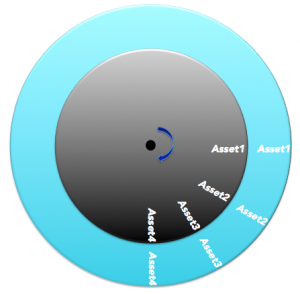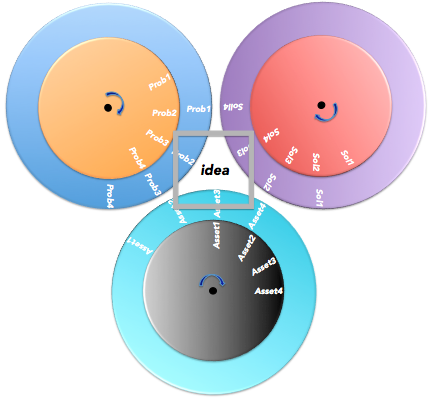A few years ago, just after I’d finished working in a startup, I was still full of entrepreneurial spirit so I set about trying to have another idea. My goal was to have a new idea a week written up as a short document. I stopped when I had eight. Some of them were half-decent, some were a little odd. I picked the best of them and trying to get them moving but, with one thing and another, my new job took over and that was that. I still have them written up and, even a few years on, some are still valid and haven’t really been done yet. Maybe I’ll… maybe not.
Anyway, the process that I used to generate the ideas was very simple and it appeared, at least for those 8 weeks, to work. The process, such as it was, was essentially just a way of thinking about things. I was reminded of it recently, started scribbling and ended up with a visual representation (and a few extra bits added in).
This does not, in itself, directly generate ideas – it can – but more often it stimulates the thoughts that ultimately produce the idea. Specifically, it can help with finding the non-obvious because it forces you to think about combinations of things that you may not naturally put together. This will obviously create a lot of nonsense to discard but that doesn’t take long and it’s worth it for the benefit of finding the non-obvious. It isn’t foolproof, however, if you put garbage in, you get what you deserve. The process hinges on the quality of the lists you create, so…
Create Three Lists
You start by creating three lists which I will call Problems, Assets and Solutions. Each is defined as follows:
Problems
This is the list of things, domains, processes, problems that you’d like to improve. These can be as broad or as specific as you want/need them to be. In an entrepreneurial sense, you would perhaps list the business domains that you want to innovate in. Within the bounds of your work environment you could list specific areas you’d like to improve or problems you need to solve.
Assets
The asset list contains things you have at your disposal to help solve the problem. Again this can be broad or specific. It could be your people, your customer’s data or lots of spare widgets lying in the warehouse. The asset list should contain a blank entry – which I’ll explain in a bit.
Solutions
The solutions list contains the tools, techniques and disruptive technologies that you’re aware of or, after some research, you’re now aware of. There are usually lots of easy ones to spot at any given time as the tech press will be banging on about them endlessly e.g. cloud, virtualisation, VR, drones, 3D printing, big data. There should also be some more practical, nearer to home stuff. This list should also contains things that you have already done successfully in your organisation and they don’t have to be technologies they could be processes or methodologies. The solutions list should also contain a blank entry.
Create the Wheels
Now, before we go all Blue Peter, you don’t actually have to create the wheels. You can work the process without them but the wheels may help you visualise the process. I’ve never actually made the wheels, it’s just how I drive the process in my head. But let’s just pretend we’re going to do it so we can see how to visualise it.
You are going to create six wheels, two for each list. Let’s look at the problem wheels – in this example, we’ll consider we have four problem areas or domains of interest.

The second problem wheel sits inside the first and, with this set of wheels alone, you can spin it to create combinations of possibly adjacent or related problems.
You then so exactly the same with the list of assets and solutions to create two more sets of two wheels, thus:


Spinning The Wheels
Once you have your six wheels, you arrange them like this:

Any resemblance to a Bombe* is entirely accidental.
And then start spinning. You will create combinations of problems, assets and solutions that you can test to see if they a) make any sense and b) have any merit. You will obviously generate lots of nonsense stuff – but you hope you can find the non-obvious combination. Be open-minded, give every combination a chance – even just for a second – you never know.
The secondary wheels allow you to create combinations so perhaps two assets or two solutions could go together to solve a problem. The blank space in the assets and solutions allows you to either not combine with anything or realise that a problem only needs a solution (and no asset) etc.
As you spin the wheels you can create simple sentences in your head to test i.e.
Can I improve Problem 1 with Solution 3 using Asset 2?
or, with a combination of things:
Can I improve Problem 3 with Solution 2 using Asset1 and Asset3?
I might build a Javascript version of this over the holidays if the mood takes me.
There has been a lot written recently about how Apple never invented anything and how their success is based on well-designed combinations of existing technologies. What this approach tries to do (in wheel form or not) is to find non-obvious solutions to problems using available applications of technologies, tools or techniques. Yes, you may end up with the suggestion that you can use drones to improve your recruitment processes or you can 3D print your way out of a problem with your procurement but maybe, just maybe, you’ll find that one eye-opening combination that has legs and could fly, although, using legs to fly is not a good combination.
* a bombe



